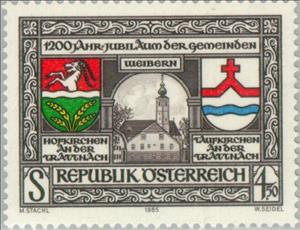Stamp: Coat of arms of Hofkirchen and Taufkirchen, Weibern church (Austria 1985)
Coat of arms of Hofkirchen and Taufkirchen, Weibern church (Austria 1985)
30 August (Austria ) within release Hofkirchen and Taufkirchen goes into circulation Stamp Coat of arms of Hofkirchen and Taufkirchen, Weibern church face value 4.50 Austrian schilling
| Stamp Coat of arms of Hofkirchen and Taufkirchen, Weibern church in catalogues | |
|---|---|
| Michel: | Mi:AT 1824 |
| Yvert et Tellier: | Yt:AT 1653 |
Stamp is horizontal format.
Stamp Coat of arms of Hofkirchen and Taufkirchen, Weibern church it reflects the thematic directions:
A coat of arms is an heraldic visual design on an escutcheon (i.e. shield), surcoat, or tabard. The coat of arms on an escutcheon forms the central element of the full heraldic achievement which in its whole consists of shield, supporters, crest, and motto. A coat of arms is traditionally unique to an individual person, family (except in the United Kingdom), state, organisation or corporation.
A church building, often simply called a church, is a building used for Christian religious activities, particularly worship services. The term in its architectural sense is most often used by Christians to refer to their religious buildings, but it is sometimes used (by analogy) for buildings of other religions. In traditional Christian architecture, the church is often arranged in the shape of a Christian cross. When viewed from plan view the longest part of a cross is represented by the aisle and the junction of the cross is located at the altar area. Towers or domes are often added with the intention of directing the eye of the viewer towards the heavens and inspiring church visitors. Modern church buildings have a variety of architectural styles and layouts; many buildings that were designed for other purposes have now been converted for church use; and, similarly, many original church buildings have been put to other uses. The earliest identified Christian church was a house church founded between 233 and 256. During the 11th through 14th centuries, a wave of building of cathedrals and smaller parish churches occurred across Western Europe. A cathedral is a church, usually Roman Catholic, Anglican, Oriental Orthodox or Eastern Orthodox, housing the seat of a bishop.



